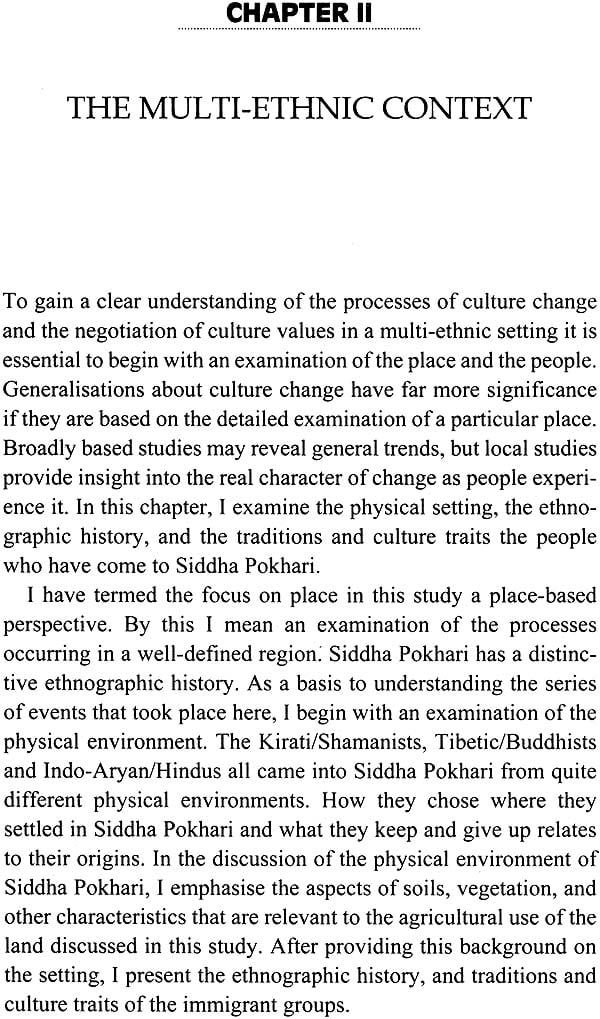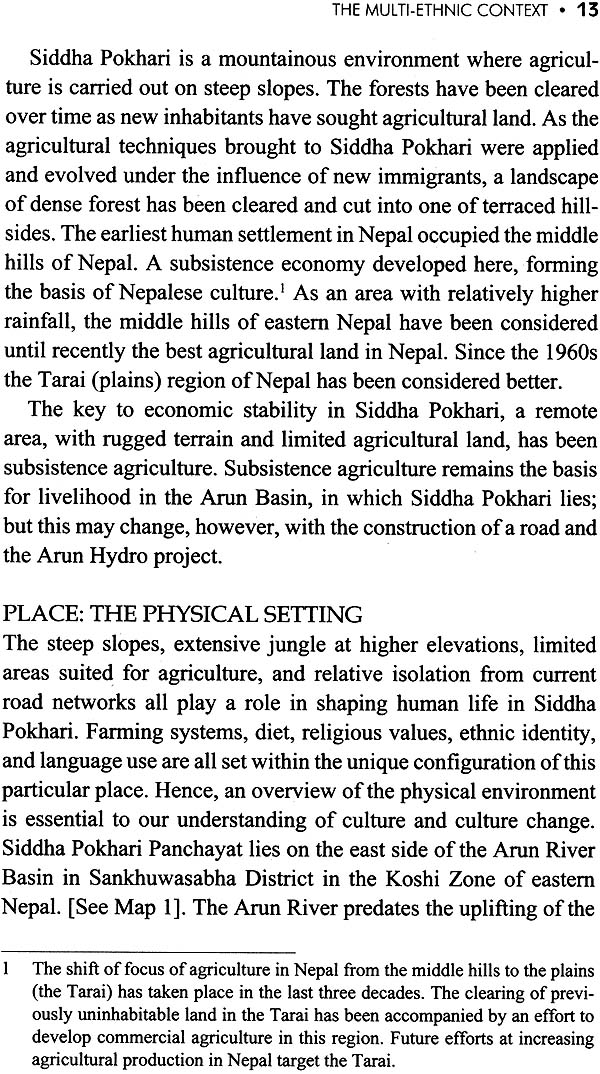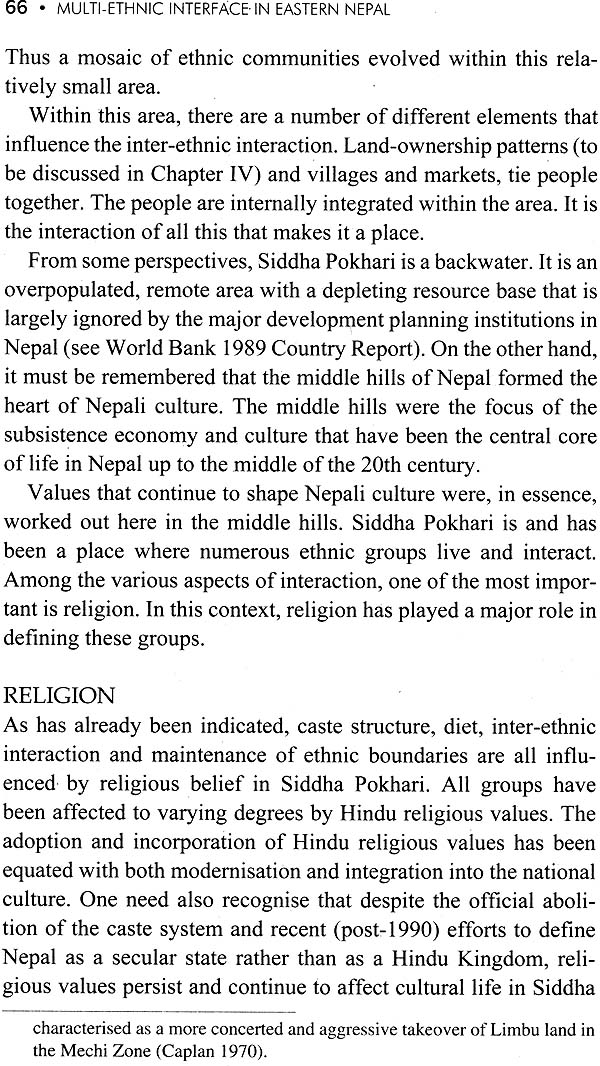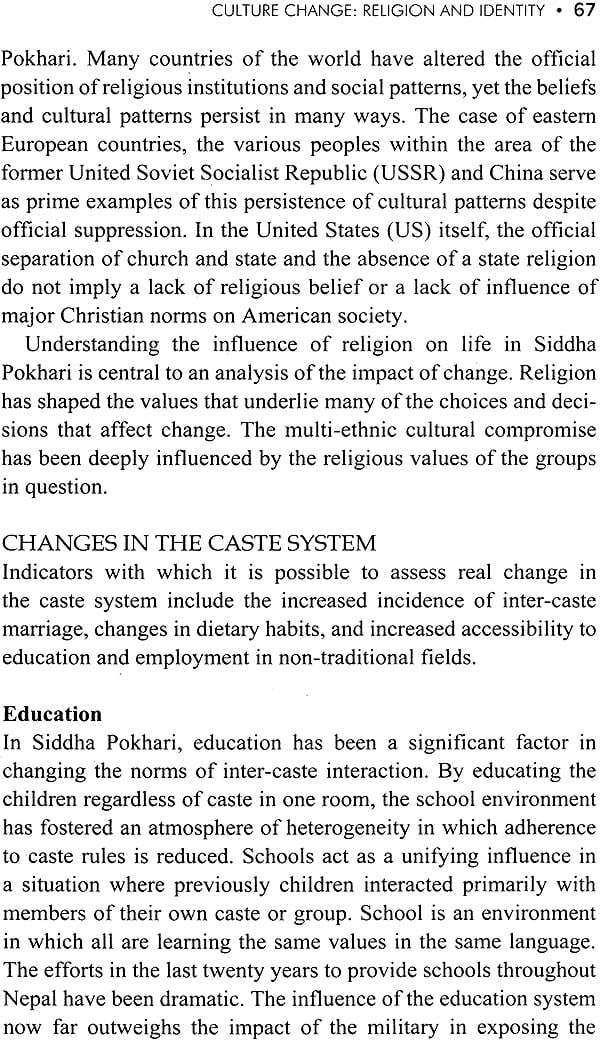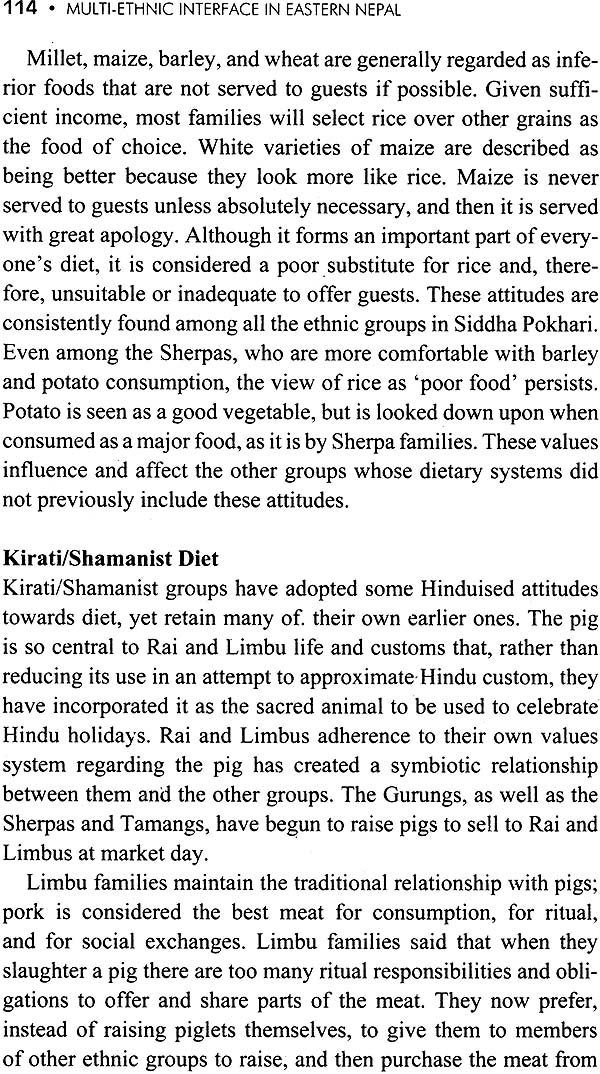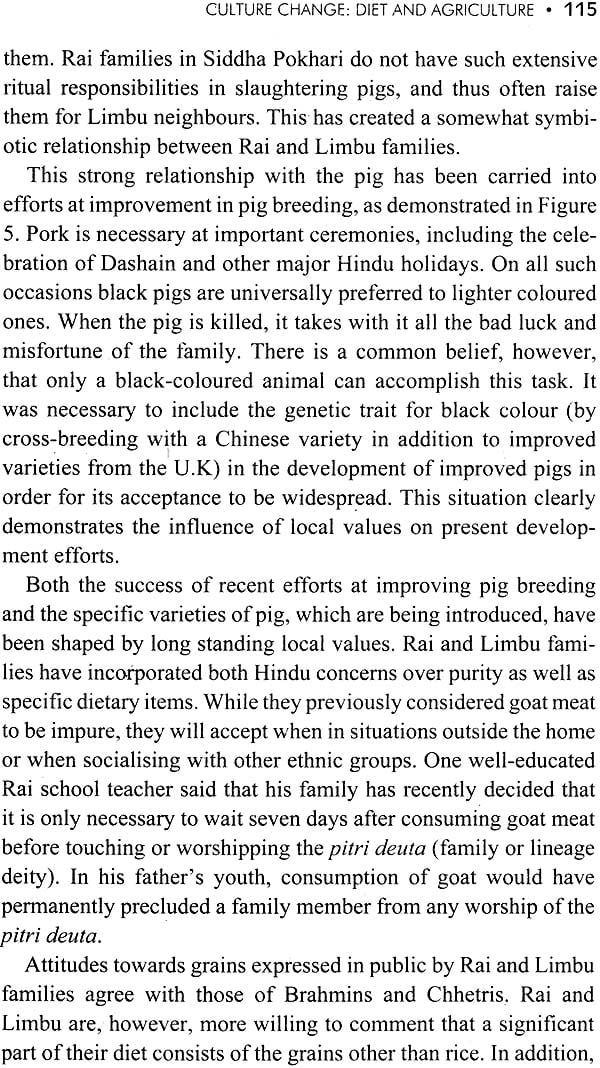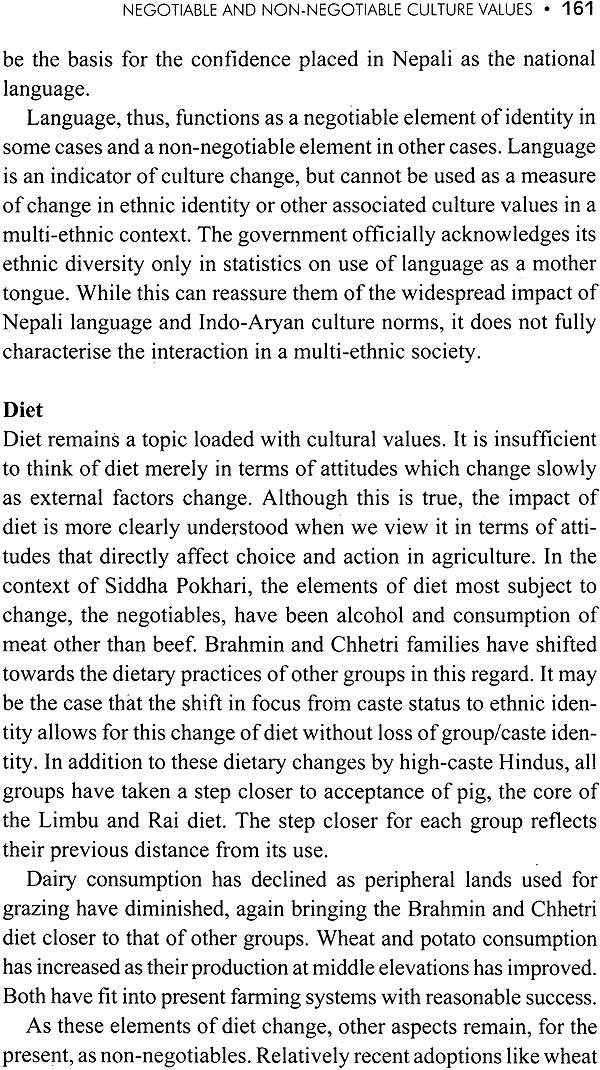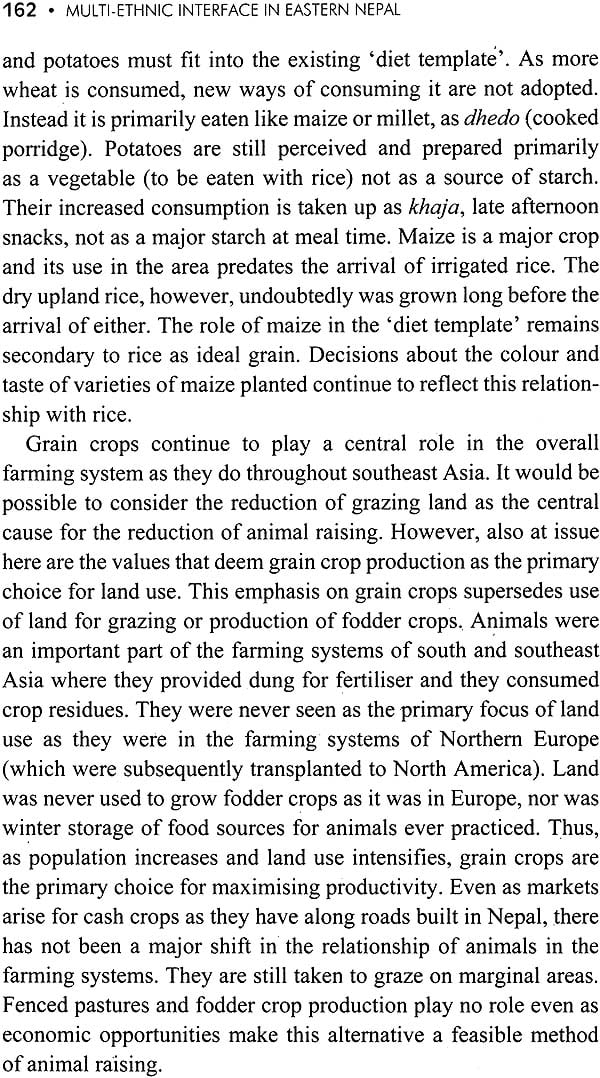
Multi - Ethnic Interface in Eastern Nepal (Culture Change in Siddha Pokhari)
Book Specification
| Item Code: | NAM614 |
| Author: | Anne Zonne Parker |
| Publisher: | Himal Books, Nepal |
| Language: | English |
| Edition: | 2013 |
| ISBN: | 9789937597036 |
| Pages: | 213 |
| Cover: | Paperback |
| Other Details | 8.5 inch x 6.0 inch |
| Weight | 300 gm |
Book Description
Multi- Ethnic Interface in Eastern Nepal captures the complex and evolving dynamic between Nepal’s diverse ethnic groups in co-creating the landscape and the culture they live in . This exploration of Siddha Pokhari in eastern Nepal offers a intimate glimpse into the relationships between ethnic and caste groups, illuminating the nuanced processes and emergent properties of the interface of peoples, beliefs and culture. The dynamics described here, inspired by Nepal’s exceptionally multi-ethnic scene, can provide a lens through which to understand the meeting of peoples in a world were multiple perspectives increasingly interface with each other, raising questions such as: What beliefs persist and why? How do conflicting but strongly held views merge or diverge in a shared cultural context? What is the dynamic between power and persistence? How are ethnic identities defined over time and change? How literally do we shape the earth and landscapes we live in based on our cultural lenses? This book takes you to the elegant landscapes of the steeply carved hills of eastern Nepal and the lives of its many people as it delves for the answers.
Cover shows Mindu Sherpa and his family, They had moved to Siddha Pokhari from Maiam in 1986, two years before the photo was taken so that the children could go to school. In their fields, which lay at a higher elevation than the village, they were growing potatoes, maize, barley and wheat. Their primary language is Sherpa (which they said is the same as that spoken in Solukhumbu).
Anne Z. Parker is Professor of Environmental Studies at Naropa University, Colorado, where she teaches Geography and Environmental Leadership courses in the BA in Environmental Studies and the MA in Environmental Leadership. She received her PhD in Geography from the University of Oregon, MA in Inner Asian Studies from Indiana University, and BA in Conservation of Natural Resources from University of California Berkeley. She has travelled, studied and carried out research thought the Himalayan region. Multi-Ethnic Interface in Eastern Nepal is based on her PhD research carried out in the hills of eastern Nepal.
Nepal is currently undergoing tremendous change as glass ceilings break on caste and ethnic boundaries, and as it works to find a new vision of itself as a multi-ethnic country. Rising from the rubble of intensive internal conflict over the last two decades Nepal may find that it has much to bring to the global conversation in this quest for a new model of multi-cultural national identity where the many voices and values need to be heard and considered.
Unlike the much touted 'melting pot' concept used in the United States that sought to bring new people into one collective identity, while primarily imposing 'mainstream', mostly English, cultural values on incoming peoples, Nepal had represented itself as a 'flower garden' where diverse identities were not required to blend. The attractiveness of this image hid the reality of the caste system, which restricted caste and ethnic group intermarriage in previous decades and imposed many hidden barriers on social, educational, intellectual, and political life. The struggle of minority people in Nepal has continued over the last century despite the formal end of the caste system and the recent populist upheavals of the Maoist insurgence. However, noticeable change is taking place in Nepal. In the midst of these last two decades of intense desire to break open the old cultural and economic system, things are shifting in the political and cultural discourse within Nepal. To paraphrase a number of Nepalese colleagues , Now it seems like so many different voices have to be considered; everyone wants to have a stake in things'.
Multi-Ethnic Interface offers a glimpse into the complexity underlying Nepal as a modem nation and explores the multifaceted daily negotiation of cultural values that shape its land and people. With its 92 languages and estimated 103 distinct castes and ethnic groups, as enumerated in the 2001 census, Nepal is one of the most culturally diverse regions of the world. Based on field- work carried out in 1988 and 1989 this work offers a baseline for understanding the changing agricultural landscape of Nepal and a template for mapping cultural change in multi-cultural settings. Much of the anthropological work previously done in Nepal had focused on individual ethnic groups, documenting the unique customs, languages, and cultural traits •of each ethnic group. Little work had been done on the interactions between the groups, particularly in settings in which multiple groups were interacting. This study assumes the position that all the groups are key to the future, health, and identity of Nepal and that simply generalizing a pan-Nepali identity is unworkable to access the cultural life of the country, while at the same time recognizing that governmental structures, school systems and curricula, and other shared cultural forms are key to the functioning of a nation. These centralizing national forces need not be seen as contradictory to or suppressive of diversity of cultural life. This work also captures some aspects of the lives and historical situation of peoples of the eastern hills who rarely found their voices and lives represented in Western academic or Nepali upper-caste representations of Nepali life.
While economics play a significant role in culture change and agricultural adaptation, most western-framed research has often over-emphasised this as the sole or most vital factor. As you will see in this book a whole host of other values are shaping decisions and choices underlying agricultural land use, change, choices, and outcomes. The study specifically focuses on these factors and offers a framework for mapping such changes that can be fruitful in any multi-cultural context. The study explores one area of the Koshi Anchal in the eastern hills of Nepal called Siddha Pokhari. It is not the specific outcomes of the negations of cultural values in this region that can be applied elsewhere, but the method of mapping culture values itself. In the same way that agricultural land use cannot be generalised over the country due to the incredible diversity of altitude, slope, aspect, soils, vegetation and so on that presents itself across this mountainous region, so too the cultural and ethnic mix varies from place to place over the entire country resulting in a diverse mosaic of expressed values. The example of the role of the pig in Siddha Pokhari, described in the book, demonstrates not simply the permanent triumph of one cultural value over another, but rather a complex and dynamic conversation with shifting trade-offs that resulted in unexpected outcomes. In this case, the nationally dominant Hindu caste view of the pig as unclean did not outweigh the strong value among the locally numerically dominant Kirati (Rai and Limbu) communities of the pig as the most sacred animal. The colour and purpose of the pig in Kirati community life, however, shaped the future pathway of pig genetics of the region in unique and unexpected ways, and began to make hidden changes in diet among other groups.
On another level this work is an ode to, or love story about, a particular place. Siddha Pokhari is a unique mixture and meeting of peoples and values. Geography holds the power of place as a high value. While principles may be applied and development processes may be occurring across a country, nothing is as important to their actual manifestation as the on-the-ground reality unfolding in a particular place. Development work can be greatly enhanced if those who are attempting to shift an agricultural land- scape work out not only the historical pattern of existing plants and animals, climatic conditions, and so on, but also the value systems that underlie the choices of those plants and animals. Those who live in a place are the ones who know it best and it is essential to look to the locals as the experts and as the long-term experimental scientists. Self-directed, locally empowered land management has had great success in Nepal following an earlier era that had emphasised national-level management. This study of one place reveals the depth of knowledge and attention to care of the land on the local level. Change in the agricultural landscape of Siddha Pokhari has marched onward, yet ever dependent upon and influenced by 'the complex mosaic of peoples and beliefs outlined herein.
In exploring the complex mosaic of ethnic groups in Siddha Pokhari, within the larger multi-ethnic context of Nepal as a whole, it is important to address the subject of ethnic group names and terminology, Terms for ethnic groups have been under some evolution, shifting from some inaccurate terms or attributes given by early non-Nepali anthropologists, through generalised perceptions by dominant groups within Nepal, to more current self- designated terms based on the much more nuanced knowledge of the people themselves. In the original version of this study, I used terms for individual ethnic groups which, while in some cases somewhat generalised, still stand as effective terms for individual ethnic groups within the region. However, the meta- group terminology used in the original text has been changed. I used the terms 'Indo-Aryan', 'Tibetic', and 'Burmitic' as large meta- groups to designate not language families, but land use strategy meta-categories to differentiate the land use practices of these three meta-groups, 'Indo-Aryan' was used to designate the rice- growing, lower-elevation strategies of the Hindu caste groups who came to Siddha Pokhari from the west and south of Nepal.
'Tibetic' was the general term for peoples who migrated from Tibet and very high elevation areas of Nepal into Siddha Pokhari, bringing with them high elevation land-use strategies, plants and animal, and who, as result of living in very fragile environments, are very interestingly prone to creative innovation and adaptation of new methodologies. The term 'Burmitic' was used for people who migrated into this region very early from the east, the general direction of Burma. In the Siddha Pokhari region, this indicates a complex mosaic of peoples arriving in different time periods, often generally called Rai and Limbu, who are very knowledge- able about use of local plants and animals, and who sometimes used swidden agricultural techniques. While 'Indo-Aryan' and 'Tibetic' have been found to be adequately acceptable meta-terms for the peoples described above, the term 'Burmitic' has been thoroughly debunked and found to be of no use in the context of Nepal. Hence, I have replaced this term with the term 'Kirati', that signifies the Rai, Limbu, and the more nuanced and complex sub-groupings of these peoples who have lived in the region the longest. This term too ultimately has its limitations, but it more accurately represents the peoples of this region and their sense of self-designation than the previous term. While I feel that the use of the meta-group terms was very useful for talking about land use, crops and animal-husbandry configurations, I do not believe these terms can or should be used in other contexts. The groupings themselves are flawed in that some specific ethnic groups simply do not fit exclusively in anyone meta-group. A case in point is the Gurungs who could fit into either Tibetic or Kirati categories as defined here. They are not Kirati people as commonly defined, but they are among the older, shamanic peoples who know and use the land as only long-term inhabitants could, particularly in the region of western Nepal where they have lived longest. Having abandoned the seemingly more general, but useless term Burmitic for Kirati, I have opened a new zone of the complexity and inappropriateness in trying to find a meta-term. Nonetheless, my under- lying goal to honour both the unique gifts and qualities of each ethnic group, while at the same time noting and describing some larger scale land-use histories and strategies, remains the same.
This historical study invites reflection and encourages the development of new perspectives on the multi-cultural conversation that is Nepal. What new self-definition of national identity(- ies) can emerge within this diverse cultural context? What gifts and insights can Nepal bring to a world needing to learn to embrace diversity at all levels? How can they reinvent a collective vision while abandoning exclusionary perspectives that have led to oppression of minority peoples? And, particularly relevant to this book, how will this discourse literally shape the landscape of Nepal?
One of the central concerns confronting the people of Nepal is the need to maintain agricultural production that will keep pace with basic nutritional needs in the decades ahead, while maintaining sustainable farming systems. Western governments have sought to contribute to this goal through a variety of development projects. These projects have had a mixed record of success, in particular because they were insensitive to the local context in which new agricultural techniques were applied. As a result, those involved with agricultural development have increasingly come to focus on the importance of understanding indigenous agricultural techniques.
While this increasing concern with indigenous agricultural techniques is a step forward, the attempt to view agricultural practices in isolation from their social and cultural context continues to be problematic. Indigenous agricultural practices have rarely been placed within a broader social and cultural context. The central idea of this dissertation is to show the importance of understanding that cultural context and agriculture are inextricably intertwined. A case study in Siddha Pokhari Panchayat provides the specific setting in which this idea is explained.
To elucidate the relationship between agricultural change and cultural change, it is first necessary to explain the underlying cultural context. Fundamental to the cultural context in the Siddha Pokhari area are the different peoples who live there and the interactions among them on key cultural issues. The relationship among the three major groups of people has produced the society that presently exists. Each of the groups has contributed a number of elements to the current cultural configuration; the resulting matrix is what defines the distinctive character of the region.
Awareness of the cultural context is essential to an understanding of local agricultural practices and processes. In Siddha Pokhari local diet and cultural practices shape agricultural practices in fundamental ways. Certain crops and animals are raised primarily for ritual purposes; others are entirely avoided. Agriculture cannot be extracted from the broader culture. In this. time period government efforts at agricultural development sent mixed messages to Siddha Pokhari Panchayat. Efforts to increase agricultural production through introduced seed and new farming methods had met with limited success, often because they are only marginally relevant to local conditions. Some recent efforts to take into account local beliefs and preferences have been more successful. However, the focus on technique alone provides a limited view of the processes of agricultural change.
In an effort to elucidate the links between culture and agriculture, this dissertation treats both in an integrated way. Since this dissertation explores several processes of cultural negotiation and integration between peoples that occurred on many different levels, its central theme cannot be presented in simple hypothesis form. Instead I have chosen the approach of presenting a holistic picture so that ethnic processes in multicultural areas can be better explained. In the face of the complexity of the multicultural context of this study, a mono-directional argument would have limited explanatory power.
The underlying concern that motivates my study is a desire to understand problems of land and resource use in the Himalayas. I began my work in the Himalayas steeped in the common wisdom of the 1980s that the hill farmers were the cause of rapid recent deforestation and major erosion, a notion that was based on a relatively small amount of research done in the 1970s and generalised throughout the whole Himalayan region. After close examination of farming systems in Bhutan, Sikkim, Darjeeling, and eastern Nepal, I concluded that the farmers of the middle hills of the Himalayas were careful stewards of their landscape and that traditional farming systems were both sophisticated and closely adapted to local conditions. These perceptions were reconfirmed in Ives and Messerschmidt's (1989) summary of 20 years of research on the Himalayas and by the work of Peter Whiteman (1985, 1988).
I began my observations by examining the relationship between traditional farming methods and recently introduced methods. I very quickly discovered major discrepancies between the government's goals and efforts, and what farmers were actually doing. I wanted to understand how these farming systems were actually functioning. As I carried out my field work, I discovered that to understand changes in farming systems I had to under- stand the cultural context in which they were embedded. In the case of Nepal, inter-ethnic interaction is central to the processes of culture change and thus to changes in farming practices.
Siddha Pokhari Panchayat is extremely interesting from a cultural geographic perspective. Many different peoples from various parts of Nepal have migrated to this region over the past two centuries, making it one of the most culturally heterogeneous regions of Nepal. In this relatively small area, a variety of ethnic represent Kirati/Shamanist, Tibetic/Buddhist and Indo-Aryan/ Hindu peoples living in close proximity to one another. They have come from different ecological regions, ranging from high mountainous areas in which few crops other than barley and potatoes can be grown, e.g., the Sherpas, to the drier mid-hills of western Nepal where wheat and dairy production was the central focus of farming systems, e.g., the Brahmins and Chhetris. Today these migrants live together in the temperate environment of the middle hill region of eastern Nepal in which Siddha Pokhari is located.
Studies of ethnicity, development and cultural change in Nepal have focused primarily on the individual ethnic groups. A large body of anthropological and, to some extent, sociological, literature exists on many of the ethnic groups in Nepal (Fricke 1986, Dahal 1985, von Furer-Haimendorf 1979, McDougal 1979, MacFarlane 1976, Messerschmidt 1976, Pignede 1962). Discussions of the processes of change have emphasised the 'Nepalisation' or 'Hinduisation' of non-Indo-Aryan Hindu groups or the relationship between the dominant Nepali culture and a given minority (Caplan 1970, Sagant 1976). These studies suggest that change is a mono-directional process in which the members of a minority group adopt various cultural characteristics of the national majority, such as dress, technologies, dietary habits, agricultural patterns, culture or language. Most studies of ethnicity, whether in Nepal or elsewhere, follow this model, yet frequently the cultural processes occurring within a multiethnic region are more complex. In such situations the culturally dominant group may not form a numerical majority. A wide variety of interactions between multiple groups may occur and major portions of their cultural systems may be incorporated into evolving national cultural norms. Such a situation is documented by Wixman (1980) in his work on the ethnically heterogeneous region of the Soviet North Caucasus.
The dynamics of cultural integration and ethnic interaction in Nepal, where more than two ethnic groups are involved, have not yet been sufficiently emphasised. In Siddha Pokhari it'is possible to examine ethnic interaction beyond the notion of minority/ majority relationships. Siddha Pokhari does not display the mono- directional pattern of culture change often studied by westerners. In Siddha Pokhari the relationship between an Indo-Aryan/Hindu majority and a non-Indo Aryan/Hindu minority is not dominant; it is but one of several forms of interaction. Because its physical environment, with regard to agricultural potential, is fairly uniform and can be taken more or less as a constant, Siddha Pokhari is an excellent site in which to examine the ways peoples from different elevations and cultural backgrounds accommodate to life in similar environments. Each group brought a variety of distinctive cultural traits and land-use strategies with it and over time together they have developed a fairly composite agricultural system.
Although trends in cultural integration in Siddha Pokhari have been reinforced by political integration of the nation and by accelerating factors of modernisation, ethnic identities have persisted. The historical processes of culture change can be documented through a discussion of several questions. What culture traits have characterised each group? What cultural and resource-use strategies did they bring to Siddha Pokhari? What kind of cultural and agricultural environment has been created in this multi-ethnic context?
A study at any level of resolution involves constraints. In the study of an ethnically diverse Panchayat, the detail that is possible to record in the study of a single village or ethnic group is exchanged in favour of a more general regional approach. In an effort to address the dynamic character of interaction of ethnic groups, I chose a panchayat, I the smallest political territorial unit in Nepal (equivalent to a small county) rather than a single village, as the focus of my research.' A number of studies of single villages in Nepal have revealed significant information about resource-use patterns and cultural characteristics of individual ethnic groups (Fricke 1986, Daha11985, MacFarlane 1976, Messerschmidt 1976, Pignede 1962). Yet, because individual villages in the middle hills of eastern Nepal usually contain only one to three ethnic groups, I felt I needed a slightly larger area of focus if I were to gain better insight of inter-ethnic interaction.
In my year and a half of fieldwork in Nepal, I conducted extensive interviews with a representative selection of 10 percent of families in each ward of the Panchayat. I used both fixed questionnaires and open-ended interview formats, i.e., tape-recorded discussions. [See Appendix A]. In order to place the trends in Siddha Pokhari in a larger context, I also used a short form of the questionnaire in several other panchayats in Sankhuwasabha district. In addition, my long-term observations and participation in local life contributed to this study.
Each chapter includes a theoretical overview, a discussion of place as it relates to the topic of the chapter, and a discussion of selected culture traits. Chapter II presents the settings which form the context of the study: physical environment, ethnographic history, and relevant ethnic traits. This background information is essential to understanding the dynamics of inter-ethnic relations in this region. The three major groups of the region each came from different ecological backgrounds and then evaluated the physical setting of Siddha Pokhari in different terms and have evolved in different ways. Basically the material presented in this chapter surnmarises the existing literature on the physical and cultural nature of the Koshi Zone of eastern Nepal and the ethnic groups represented in the area.
I examine the more important issues of cultural interaction between the various groups in Chapter III. I present relevant aspects of religion, ethnic identity and language that I observed during my stay in the region. Changes in caste, language and a variety of culture traits demonstrate the general cultural trends taking place in the region. Whereas in Chapter II, I describe the distinct traits of the immigrants, in Chapter III, I describe the dynamic relationships between the immigrant groups.
Chapter IV specifically addresses issues of diet and agriculture-the nexus of ethnicity and locality. Because diet, a major ethnic characteristic, plays a key role in shaping agriculture, it is reflected in the current landscape. It is seen in this chapter that the current agricultural landscape reflects not only the diet of these people, but also illustrates the complex ethnic and cultural history of the region. I use the concept of negotiation as a particularly useful way of explaining the landscape.
In Chapter V, I present the results of my examination of the two central themes: cultural context and the relationship between culture and agriculture. I describe the elements of culture change that are either negotiable or non-negotiable. The negotiability and non-negotiability of various culture traits have played a role in shaping the agricultural and cultural patterns as well as the land- scape in the region. I conclude in Chapter VI with the ways in which 'negotiability' can be used in understanding the possible impact of agricultural development projects.
| Acknowledgements | xi | |
| Preface 1991 | xiii | |
| Preface 2013 | xxi | |
| I. | INTRODUCTION | 1 |
| Research Methods | 7 | |
| Research Perspective | 8 | |
| II. | THE MULTI-ETHNIC CONTEXT | 12 |
| Place: The Physical Setting | 13 | |
| Ethnographic History | 21 | |
| Pre-Eighteenth Century Settlement | 25 | |
| Post-Eighteenth Century Settlement | 29 | |
| Culture Traits | 31 | |
| Religion | 31 | |
| Ethnic Identity | 35 | |
| Language | 39 | |
| Diet | 42 | |
| Farming Systems | 47 | |
| III. | CULTURE CHANGE: RELIGION AND IDENTITY | 51 |
| Introduction | 51 | |
| Indo-Aryan Hindu Influences on Other Groups | 53 | |
| The Caste System | 54 | |
| History of the Caste System in Nepal | 56 | |
| Buddhist Values | 57 | |
| Shamanist Values | 59 | |
| Lower Castes | 59 | |
| The Nepali National Culture Norm | 61 | |
| Siddha Pokhari as Place | 63 | |
| Religion | 65 | |
| Changes in the Caste System | 67 | |
| Education | 67 | |
| Employment | 69 | |
| Inter-caste Marriage | 69 | |
| Changes in Caste-related Dietary Customs | 73 | |
| and Taboos | ||
| Overall Trends | 74 | |
| Religious Rituals and Festivals | 74 | |
| Identity | 81 | |
| Social Interaction | 84 | |
| Conclusion | 98 | |
| IV. | CULTURE CHANGE: DIET AND AGRICULTURE | 101 |
| Introduction | 101 | |
| Place: Siddha Pokhari as Mosaic | 105 | |
| Diet | 108 | |
| Indo-Aryan Hindu Diet | 109 | |
| Kirati/Shamanist Diet | 114 | |
| Tibetic/Buddhist Diet | 116 | |
| Directions of Change | 117 | |
| Agricultural Practices | 118 | |
| Land Tenure | 118 | |
| Farming systems | 123 | |
| Grain Crops | 130 | |
| Summary | 143 | |
| V. | NEGOTIABLE AND NON -NEGOTIABLE CULTURE VALUES | 145 |
| Place: Siddha Pokhari as Microcosm | 150 | |
| Negotiable and Non-Negotiable Elements of Culture | 152 | |
| VI. | CONCLUSION | 166 |
| Implications: Culture Change in Nepal | 166 | |
| Implications: Applications to Agricultural Development | 170 | |
| Appendix | 173 | |
| Bibliography | 178 |
